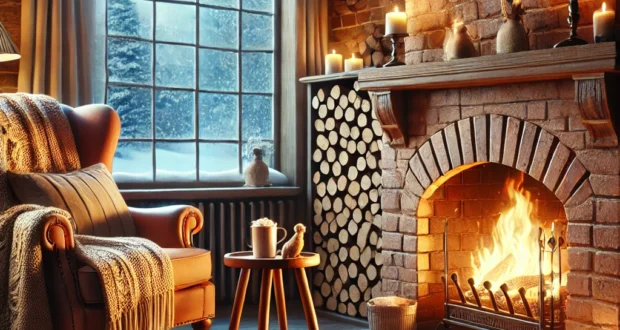Blog
How to keep fire to burning all night: a cozy winter guide
When the winter cold deepens, the heat of fire becomes one of the simple pleasures of life. Regardless of whether you use a traditional fireplace or a wood -burning oven, maintaining fire all night is both practical and comforting. This guide will lead you through the steps to maintain long -lasting fire, minimize the accumulation of ash, and even check that the heating wood is properly seasoned. Let’s start!
Step 1: Start with right wood
The type of wood you use has a significant impact on how long the fire will last and how much ash will produce.
1. Choose deciduous wood: Oak, Hickory, Klon and Beech are excellent options because they are thick, slowly smoke and produce minimal ashes. Avoid coniferous wood, such as pine or spruce, which quickly burn and leave more residues.
2. SPEEM WOOD: Properly seasoned wood (dried for at least 6 months) should have a moisture content of 20% or less. The use of wet or “green” wood causes smoky, inefficient fire and excess ash.
How to check the moisture content of wood
1. Use a moisture meter:
- Divide the journal and test a freshly cut surface with a moisture meter, available in most equipment stores.
- The wood is ready to burn if the reading is below 20%.
2. Look for visual characters:
- The wood seasoned is darker, with cracked ends and loose bark.
3. Perform the sound test:
- Tap two pieces of wood together. Dry wood makes a sharp, empty sound, and wet wood produces a matte bang.
4. Feel the importance:
- Dry wood is noticeably lighter than freshly cut wood of the same type.
5. Check the burning behavior:
- Dry wood lightly lighting, burns gradually and produces small smoke. Wet wood hisses, burns excessively and tries to light.
- By making sure that the wood is properly seasoned, you will enjoy a cleaner, longer fire with less ash to clean.
Step 2: Prepare a fireplace or bake
Preparation is the key to an efficient fire:
- Clean excess ash:
- A small layer of ash (about inch) can insulate the fire and improve heat retention. However, too much ash limits air flow, so clean your box regularly.
- Check your chimney:
- The clean chimney ensures adequate air flow and reduces the accumulation of creosotes, which may hinder fire efficiency and pose a security threat. Chimney control and cleaning annually.
Step 3: Build a fire correctly
To maximize combustion time and minimize ash production, use Top -down method:
1. Place the largest logs at the bottom.
2. Add smaller dailies or burns on top.
3. End with a crushed newspaper or fire starters at the very top.
4. Fire lighting from above allows him to gradually burn down, creating less smoke and ash.
Cozy when a fire on a snowy winter night, in which warmth and comfort make the perfect withdrawal from the cold outside.
Step 4: Fire bank for night burn
To make fire burn all night, follow these steps:
1. Let him burn to the heat:
Before bedtime, let your fire be reduced to the bed of glowing bulbs.
2. Stop coal:
Use a fire poker to move the heat to the back of the fireplace or stove.
3. Add large wood diaries:
Place a few large, experienced logs made of hard wood over the Że Że. They will burn slowly and gradually.
4. Adjust the airflow:
- In a wood -burning oven, partially close the silencer to reduce air flow and control the combustion speed.
- To get a fireplace, use a fire screen for safety and containing heat.
5. Optional ash cover:
In a wooden oven, sprinkling a thin layer of ash after the heat before adding logs, it can help in insulation of coal and prolong the burn.
Step 5: Minimize the accumulation of ash
While some ashes are inevitable, these tips can help reduce accumulation:
- Burn seasoned deciduous wood: This produces less ash than coniferous wood.
- Avoid paper or cardboard: These materials are burning quickly and leave excessive ash. Instead, use fire starters designed for fireplaces or furnaces.
- Empty ash safely: Wait until the ashes are completely cool before put them in a metal container with a lid. Ask you can change in gardens or when the ice melts in winter.
Step 6: Use helpful tools
Investing in several tools can facilitate fire maintenance:
- Fireplace: fireplace: They improve air flow and promote efficient combustion.
- Ash Incums: Specially designed for cleaning ash, make the task fast and free of mess.
- Moisture meters: They provide properly seasoned heating wood.
Safety first: important reminders
- Install smoke and carbon monoxide detectors: Make sure they work, especially near the fire zone and in the bedrooms.
- Never leave fire unattended: Always safely the band’s fire before going to bed.
- Getting out to fire fire extinguishers: Get ready for crisis situations.
Wake up on a warm hearth
Thanks to these tips, you wake up to glowing heat, ready to disseminate over the upcoming day. Building a fire that lasts all night, not only keeps warm … creates a cozy, comforting atmosphere that makes winter nights magical.
So take a warm blanket and your favorite book and enjoy a crackling fire. There is nothing similar to racing winter

